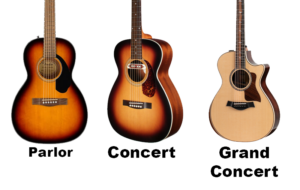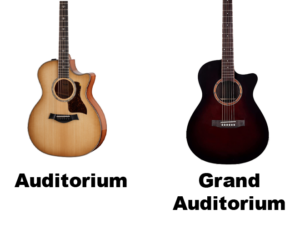Uncategorized
Mastering the Chords for Folsom Prison Blues: A Beginner’s Guide
Embarking on a musical journey with the guitar is like unlocking a treasure chest of melodies and rhythms that bring stories to life. Among the timeless tunes that have captivated generations, “Folsom Prison Blues” by Johnny Cash stands as an iconic example. Learning the chords for “Folsom Prison Blues” is not only a rite of passage for guitarists but also a window into the world of classic country music. In this article, we’ll explore the chords that form the backbone of this beloved song, offer practical fingering tips, and unveil the significance of mastering these chords for your guitar-playing repertoire. Get ready to dive into the chords for “Folsom Prison Blues” and embrace the spirit of the Man in Black!
Introducing the Chords for “Folsom Prison Blues”
“Folsom Prison Blues” features a sequence of chords that create its distinct and recognizable sound. The chords used in the song are E, A, and B7. While these chords may seem simple, they come together to form the foundation of the song’s rhythmic and melodic structure.
Playing the Chords for “Folsom Prison Blues”
Follow these steps to master the chords for “Folsom Prison Blues”:
1. E Chord: Begin with the E chord. Place your index finger on the 1st fret of the G string (third from the top), your middle finger on the 2nd fret of the A string (second from the top), and your ring finger on the 2nd fret of the D string (fourth from the top). Strum from the low E string to the high E string (thinnest string).
2. A Chord: Transition to the A chord. Keep your index finger in place and move your middle and ring fingers to the 2nd fret of the D and G strings, respectively. Strum from the A string to the high E string.
3. B7 Chord: Finally, play the B7 chord. Place your index finger on the 1st fret of the D string, your middle finger on the 2nd fret of the A string, and your ring finger on the 2nd fret of the G string. Strum from the A string to the high E string.
Benefits of Learning the Chords for “Folsom Prison Blues”
Mastering the chords for “Folsom Prison Blues” offers several benefits for guitarists:
1. Classic Repertoire: Learning this iconic song introduces you to the world of classic country music and adds a timeless tune to your repertoire.
2. Rhythm and Timing: Practicing the chords enhances your sense of rhythm and timing, helping you develop steady strumming patterns and groove.
3. Song Interpretation: As you become proficient with the chords, you can experiment with different strumming styles, dynamics, and embellishments to put your unique stamp on the song.
Practical Tips for Mastering the Chords for “Folsom Prison Blues”
Here are some practical tips to help you excel in playing the chords for “Folsom Prison Blues”:
1. Finger Placement: Focus on placing your fingers accurately and pressing down firmly on the strings. This ensures that each chord rings out clearly without any muted or buzzing notes.
2. Chord Transitions: Practice transitioning between the E, A, and B7 chords smoothly. Start slowly and gradually increase your speed as you become more comfortable.
3. Strumming Patterns: Experiment with different strumming patterns to create various textures and dynamics. Try strumming with your fingers or using a pick, and feel free to incorporate pauses and accents for added flair.
Famous Songs Featuring the Chords for “Folsom Prison Blues”
“Folsom Prison Blues” is not only a classic itself but has also inspired various renditions and covers by artists across genres. Here are a few examples:
1. “Folsom Prison Blues” by Johnny Cash: The original version by the Man in Black remains a timeless and influential classic.
2. “Live at Folsom Prison” Album: Johnny Cash’s live album, recorded at Folsom State Prison, features an electrifying performance of the song that captures the essence of the live experience.
3. “Folsom Prison Blues” by Everlast: This bluesy and soulful rendition adds a fresh twist to the iconic tune, showcasing its adaptability across different musical styles.
Conclusion: Embrace the Music’s Heartbeat!
Congratulations, you’ve ventured into the world of “Folsom Prison Blues” and its captivating chords! By mastering these chords, you’ve connected with the rich heritage of classic country music and added a timeless piece to your musical arsenal. Whether you’re strumming along to Johnny Cash’s iconic rendition or putting your spin on the song, the chords for “Folsom Prison Blues” offer a gateway to rhythmic storytelling and emotional expression.
As you continue your guitar-playing journey, remember that practice and dedication are key to mastering any song. Embrace the challenges, celebrate your progress, and let your love for music guide you forward. With consistent effort and a passion for learning, you’ll find yourself playing “Folsom Prison Blues” effortlessly and infusing it with your unique style.
The chords for “Folsom Prison Blues” are just the beginning of your musical odyssey. As you explore further, you’ll encounter a diverse array of songs, techniques, and musical concepts that will enrich your playing and allow you to create melodies that resonate with your heart and soul. So, keep strumming, keep learning, and most importantly, keep enjoying the wonderful journey of creating music with your guitar. Happy playing!
Uncategorized
Acoustic Guitar Sizes: Finding Your Perfect Fit
Have you ever wondered how the size of an acoustic guitar affects its sound? From the intimate, focused tones of a parlor guitar to the deep, resonant sound of a jumbo, the size and shape of an acoustic guitar can have a profound impact on its sonic characteristics.”
In this article, we’ll explore acoustic guitar sizes, their variations, and how to choose the perfect size that suits your needs.
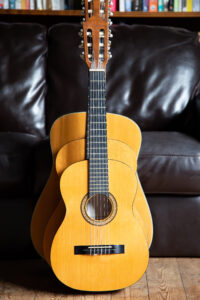 Understanding Acoustic Guitar Sizes: A Musical Puzzle
Understanding Acoustic Guitar Sizes: A Musical Puzzle
Acoustic guitar sizes refer to the dimensions and proportions of the guitar body, which significantly influence the instrument’s tonal characteristics, projection, and playability.
Just like pieces of a musical puzzle, different sizes create distinct voices that cater to various playing styles and preferences.
The Spectrum of Acoustic Guitar Sizes
Acoustic guitars come in several sizes, each with its unique qualities and attributes. Let’s explore some common acoustic guitar sizes and their defining features:
-
-
Parlor Guitar: The parlor guitar is petite and charming, making it an ideal companion for intimate settings.
The name comes from the rooms in which the guitar was typically played in the late 19th century.
Some famous musicians who have been known to use the parlor guitar are, Eric Clapton, Mark Orton, Ed Sheehan, and John Mayer
Its smaller size results in a focused and balanced sound, perfect for fingerpicking and folk music.
-
Concert Guitar: Slightly larger than the parlor guitar, the concert guitar offers enhanced projection and volume. It strikes a balance between portability and sound, making it versatile for various genres.
It is often used in classical music and flamenco music with its full sound.
-
Grand Concert Guitar: With a larger body than the concert guitar, the grand concert guitar boasts a fuller sound and improved tonal complexity.
A popular choice for those who have a smaller stature and require an instrument that’s built to a shorter scale. Great choice for traveling musicians who often play live performances.
It’s suitable for fingerstyle playing and intricate arrangements.
-
Auditorium Guitar: The auditorium guitar, also known as the orchestra model (OM), features a well-rounded sound with a pronounced midrange.
More shallower than the dreadnought and narrower in width than a concert guitar. An Auditorium guitar brings the body closer to the player, making it feel more intimate and comfortable for stage use.
Some famous musicians who play it include Ed Sheeran, John Mayer, and Eric Clapton.
-
Grand Auditorium Guitar: Expanding on the auditorium guitar’s design, the grand auditorium guitar offers a versatile sound profile with enhanced bass response and overall volume.
It is a versatile mid-sized guitar that is a good choice for those who want a single guitar to travel with. The tone is great for strumming and picking. It performs well on stage and in the studio.
It suits a wide range of musical genres.
-
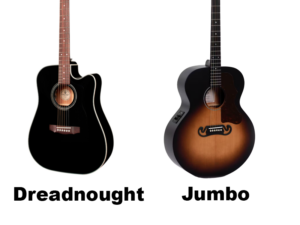 Dreadnought Guitar: The Dreadnought is a true icon, known for its bold and powerful sound. Its large body produces a strong bass response, making it ideal for strumming and vocal accompaniment.
Dreadnought Guitar: The Dreadnought is a true icon, known for its bold and powerful sound. Its large body produces a strong bass response, making it ideal for strumming and vocal accompaniment.This guitar is known for its powerful voice and lower-mid-rich tones that make it a favored choice for country artists. Although it is a popular choice for musicians of all genres.
Some famous musicians who play the dreadnought guitar include Hank Williams Jr, Elvis Presley, Keith Richards, Thom Yorke, and Kurt Cobain.
The original dreadnought guitars were made for the Oliver Ditson Company and featured mahogany backs and sides and spruce tops.
-
Jumbo Guitar: The jumbo guitar lives up to its name with a massive body that delivers robust volume and a deep bass presence.
This is the largest of the guitar family with a deeper body than the popular dreadnought. The body is wider and deeper than traditional acoustic guitars, which gives them a unique appearance.
Jumbo’s are well suited to rhythm guitarists in country and folk rock, and produce a deep rich sound favored by heavy strummers. Some famous musicians who play this guitar are Elvis Presley, George Harrison of the Beatles, Neil Young, Sheryl Crow, and Pete Townshend of The Who.
Choosing the Right Acoustic Guitar Size for You
Selecting the right acoustic guitar size involves considering factors such as playing style, comfort, and tonal preferences. Here are some steps to guide you on your quest:
-
Identify Your Playing Style: Determine whether you lean towards fingerpicking, strumming, or a mix of both. Different sizes excel in different playing styles, so choose one that complements your technique.
-
Consider Body Comfort: Hold and play guitars of various sizes to assess comfort. A guitar that fits well against your body ensures a pleasant playing experience, especially during extended sessions.
-
Evaluate Sound Preferences: Listen to the sound produced by different acoustic guitar sizes. Pay attention to tonal qualities, such as warmth, brightness, and projection, to find the one that resonates with your musical taste.
The Influence of Acoustic Guitar Sizes on Music
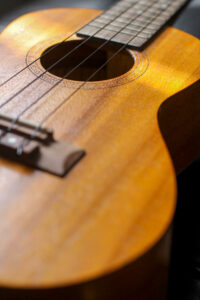 Acoustic guitar sizes and shapes can have a significant impact on the sound of the instrument.
Acoustic guitar sizes and shapes can have a significant impact on the sound of the instrument.The size of the guitar body type also relates to the volume of air within the instrument. Changes to the air capacity of the body will emphasize specific frequencies. A smaller body will have a more focused sound centered on higher frequencies, while a larger body will produce deeper low-end frequencies.
Body dimensions can provide some indication of the tone you might expect, but other factors exert a profound influence, too. Much depends on the tonewoods used to construct the body and the shape, size, and layout of the braces.
Finding Harmony in Acoustic Guitar Sizes
By delving into the nuances of size, sound, and playability, you’ve gained insights that will guide you toward the perfect fit for your musical aspirations.
As you continue your exploration, remember that each acoustic guitar size has its own unique voice and character. Embrace the joy of trying different sizes, celebrate the nuances of their sounds, and let your heart lead you to the one that resonates with your musical soul.
-
Uncategorized
Rock On with the A5 Chord Guitar: Unleash Power and Energy
Hello, fellow guitar enthusiasts and music lovers! Are you ready to dive into the electrifying world of the A5 chord guitar? Today, we’re delving into the realm of rock and power chords as we explore the mighty A5 chord – a driving force that adds raw energy and excitement to your playing. Whether you’re a budding guitarist ready to ignite the stage or a curious soul eager to understand the foundation of rock music, this guide will introduce you to the dynamic universe of the “A5 Chord Guitar.” So, pick up your guitar, plug in, and let’s embark on a journey filled with sonic power and musical intensity!
Unleashing the A5 Chord Guitar: The Essence of Power Chords
Think of the A5 chord as a musical powerhouse that forms the backbone of many rock and alternative tunes. This chord’s simplicity and raw intensity create an undeniable sense of power and drive, making it a quintessential element of rock music. Just like a lightning bolt on a stormy night, the A5 chord strikes with energy and sets the stage for electrifying performances.
Mastering the A5 Chord Guitar: Crafting Sonic Thunder
Let’s dive into the mechanics of forming the A5 chord on your guitar. Follow these steps:
1. Finger Placement: Begin by placing your index finger on the 2nd fret of the D string (the fourth thickest string), marking the root note (A).
2. Ring Finger: Position your ring finger on the 2nd fret of the G string (the third thickest string), forming the perfect fifth (E).
3. Strumming: Focus on strumming the A and D strings (the fourth and fifth thickest strings) while avoiding the low E string (the thickest string). You can also strum all three strings (A, D, and G) for a fuller sound.
4. Sound Check: Strum the strings individually to ensure each note rings out clearly. Adjust finger placement if needed for a powerful sound.
Exploring A5 Chord Guitar Variations: Adding Depth
While the A5 chord is inherently simple, you can add variations to enhance its sonic palette. Here are a couple of ways to experiment:
1. Add Distortion: Plug into an amplifier and apply distortion for a gritty and edgy sound that’s characteristic of rock music.
2. Palm Muting: Experiment with palm muting by resting the edge of your hand lightly on the strings near the bridge. This technique adds a percussive and rhythmic quality to your A5 chord progressions.
The A5 Chord Guitar in Action: Rock Anthems
The A5 chord’s raw power has fueled countless rock anthems. Here are a few iconic songs that showcase the might of the A5 chord:
1. “Smoke on the Water” by Deep Purple: The legendary riff that kicks off this classic tune is built around the A5 chord, creating an instantly recognizable and unforgettable sound.
2. “Blitzkrieg Bop” by Ramones: The driving force behind the punk rock revolution, the A5 chord propels the energetic and rebellious spirit of this timeless track.
Tips for Mastering the A5 Chord Guitar
As you dive into the world of the A5 chord, consider these tips to enhance your playing:
1. Focus on Precision: Strive for clean and precise strumming to ensure each note rings out clearly.
2. Experiment with Rhythm: Vary your strumming patterns to add rhythmic interest and dynamic flair to your A5 chord progressions.
3. Combine with Other Chords: Mix the A5 chord with other power chords or open chords to create dynamic chord progressions.
Conclusion: Embrace the Power of the A5 Chord Guitar
Congratulations, you’ve embarked on a thrilling journey through the electrifying realm of the A5 chord guitar. As you unleash power chords, experiment with variations, and rock out to iconic tunes, you’ll discover the A5 chord’s ability to captivate audiences and infuse your music with raw energy. Keep practicing, keep experimenting, and keep embracing the captivating allure of the A5 chord. It’s your gateway to a world of musical intensity, where each strum reverberates with sonic thunder. So, plug in, turn up the volume, and let the invigorating world of the A5 chord guitar propel you into a realm of melodies that ignite the soul and ignite the stage, one powerful chord at a time!
Uncategorized
Exploring the Vast Universe of Guitar Chords: How Many Guitar Chords Are There?
In the world of music, the guitar stands as a versatile and captivating instrument, capable of producing a rich tapestry of melodies and harmonies. At the heart of this sonic landscape lie chords—a collection of notes that, when played together, create the foundation of countless songs and compositions. But just how many guitar chords are there? The answer to this question unveils a fascinating journey through the realm of musical possibilities. Whether you’re a beginner strumming your first chords or an experienced player seeking to expand your harmonic horizons, this article will take you on a melodious exploration of the multitude of guitar chords that await your discovery.
A World of Harmony and Variation
The guitar’s six strings and fretboard layout provide an expansive canvas for chord creation. When you consider different finger positions, voicings, and inversions, the number of potential guitar chords becomes virtually infinite. From the familiar chords like C, G, and D, to the more intricate jazz and extended chords, the possibilities for chord combinations are vast and exciting.
Basic Chords and Beyond
Beginners often start with a set of foundational chords, such as A, E, and F. As you progress, you’ll encounter barre chords that allow you to play the same chord shape in different positions along the fretboard. These variations create a broader tonal palette, enabling you to infuse your playing with depth and complexity.
Exploring Different Voicings
Voicings refer to the specific arrangement of notes within a chord. For instance, the C major chord can be played in various voicings by altering the order of the notes. This variation not only adds a unique flavor to your playing but also opens up opportunities for creative exploration.
The Power of Inversions
Inversions involve changing the order of the notes within a chord, so the lowest note is no longer the root. This technique can create smoother transitions between chords and add a sense of fluidity to your playing. Inversions also enable you to navigate the fretboard more efficiently, especially during chord progressions.
Jazz Chords and Extended Harmonies
For those delving into jazz or advanced music theory, the realm of chords expands even further. Jazz chords often include extended harmonies, such as 7th, 9th, and 13th chords, which add complexity and sophistication to your playing. These chords provide a platform for intricate improvisation and lend a distinct flavor to jazz compositions.
Digital Tools and Chord Libraries
In the age of technology, musicians have access to a treasure trove of digital tools and resources that can aid in chord exploration. Online chord libraries and mobile apps offer chord diagrams, alternate fingerings, and even audio samples, enabling players to experiment with new chord voicings and progressions.
The Joy of Musical Discovery
As you embark on your journey to explore the world of guitar chords, remember that the number of possibilities is boundless. Each new chord you encounter adds another layer to your musical repertoire and enhances your ability to express emotions, tell stories, and connect with your audience.
Practical Application and Creativity
While the theoretical potential for guitar chords may be infinite, the practical application depends on factors such as the genre you’re playing and the specific mood you wish to convey. Experimenting with different chord progressions, voicings, and inversions can lead to unexpected sonic landscapes that set your playing apart and spark your creative instincts.
Conclusion
So, how many guitar chords are there? The answer is both quantifiable and limitless. While you can categorize and count a finite number of chord types, the true magic lies in the infinite variations, voicings, and inversions that can be explored and crafted by the hands of a dedicated guitarist. Whether you’re strumming a simple folk tune or embarking on a jazz odyssey, the guitar chords at your fingertips are an invitation to explore, create, and paint sonic masterpieces that resonate with your unique musical voice.
-
advanced9 years ago
How to Play “Sleepwalk” on the 3-String Guitar! Guitar TABs Included!
-
beginner8 years ago
3-String or 4-String? How to Decide Which is Right for You!
-
beginner9 months ago
Exploring Different Guitar Types: A Beginner’s Guide
-
Blues Guitar8 years ago
Go-To Tunings for Blues Slide Guitar
-
advanced9 months ago
Fun and Effective Guitar Exercises: Elevate Your Playing with These 5 Simple Techniques
-
Blues Guitar7 years ago
Jack Daniel’s Whiskey Barrel Guitar: How It’s Made and What it Sounds Like
-
Uncategorized9 months ago
Acoustic Guitar Sizes: Finding Your Perfect Fit
-
Guitars9 months ago
Bass vs Guitar: Exploring the Musical Journey

